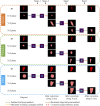Tooth image segmentation and root canal measurement based on deep learning
- PMID: 40552111
- PMCID: PMC12183224
- DOI: 10.3389/fbioe.2025.1565403
Tooth image segmentation and root canal measurement based on deep learning
Abstract
Indroduction: This study aims to develop a automated method for tooth segmentation and root canal measurement based on cone beam computed tomography (CBCT) images, providing objective, efficient, and accurate measurement results to guide and assist clinicians in root canal diagnosis grading, instrument selection, and preoperative planning.
Methods: We utilizes Attention U-Net to recognize tooth descriptors, crops regions of interest (ROIs) based on the center of mass of these descriptors, and applies an integrated deep learning method for segmentation. The segmentation results are mapped back to the original coordinates and position-corrected, followed by automatic measurement and visualization of root canal lengths and angles.
Results: Quantitative evaluation demonstrated a segmentation Dice coefficient of 96.33%, Jaccard coefficient of 92.94%, Hausdorff distance of 2.04 mm, and Average surface distance of 0.24 mm - all surpassing existing methods. The relative error of root canal length measurement was 3.42% (less than 5%), and the effect of auto-correction was recognized by clinicians.
Discussion: The proposed segmentation method demonstrates favorable performance, with a relatively low relative error between automated and manual measurements, providing valuable reference for clinical applications.
Keywords: Attention U-net; CBCT; V-Net; deep learning; root canal measurement; tooth instance segmentation.
Copyright © 2025 Chen, Liu, Wang, Ji, Gong and Gao.
Conflict of interest statement
The authors declare that the research was conducted in the absence of any commercial or financial relationships that could be construed as a potential conflict of interest.
Figures






Similar articles
-
[Study on dental image segmentation and automatic root canal measurement based on multi-stage deep learning using cone beam computed tomography].Sheng Wu Yi Xue Gong Cheng Xue Za Zhi. 2025 Aug 25;42(4):757-765. doi: 10.7507/1001-5515.202503008. Sheng Wu Yi Xue Gong Cheng Xue Za Zhi. 2025. PMID: 40887191 Free PMC article. Chinese.
-
[Segmentation and validation of mandibular canal and its bifurcation on cone beam CT based on deep learning].Shanghai Kou Qiang Yi Xue. 2025 Apr;34(2):119-125. Shanghai Kou Qiang Yi Xue. 2025. PMID: 40550761 Chinese.
-
CT-guided CBCT multi-organ segmentation using a multi-channel conditional consistency diffusion model for lung cancer radiotherapy.Biomed Phys Eng Express. 2025 Jun 20;11(4). doi: 10.1088/2057-1976/addac8. Biomed Phys Eng Express. 2025. PMID: 40393462
-
Initial arch wires used in orthodontic treatment with fixed appliances.Cochrane Database Syst Rev. 2018 Jul 31;7(7):CD007859. doi: 10.1002/14651858.CD007859.pub4. Cochrane Database Syst Rev. 2018. Update in: Cochrane Database Syst Rev. 2024 Feb 06;2:CD007859. doi: 10.1002/14651858.CD007859.pub5. PMID: 30064155 Free PMC article. Updated.
-
Optical correction of refractive error for preventing and treating eye symptoms in computer users.Cochrane Database Syst Rev. 2018 Apr 10;4(4):CD009877. doi: 10.1002/14651858.CD009877.pub2. Cochrane Database Syst Rev. 2018. PMID: 29633784 Free PMC article.
References
-
- Abulhamael A. M., Barayan M., Makki L. M., Alsharyoufi S. M., Albalawi T. H., Zahran S., et al. (2024). The accuracy of cone beam computed tomography scans in determining the working length in teeth requiring non-surgical endodontic treatment: a retrospective clinical study. CUREUS J. Med. Sci. 16, e59907. 10.7759/cureus.59907 - DOI - PMC - PubMed
-
- Al-sherif N., Guo G., Ammar H. H. (2012). “A new approach to teeth segmentation,” in 14th IEEE international symposium on multimedia (ISM) (Irvine, CA: IEEE; ), 145–148. 10.1109/ISM.2012.35 - DOI
-
- Chen Y., Du H., Yun Z., Yang S., Dai Z., Zhong L., et al. (2020). Automatic segmentation of individual tooth in dental cbct images from tooth surface map by a multi-task fcn. IEEE ACCESS 8, 97296–97309. 10.1109/ACCESS.2020.2991799 - DOI
LinkOut - more resources
Full Text Sources

